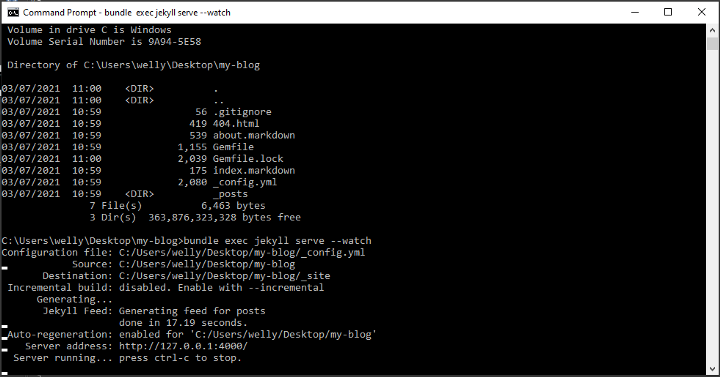

Solution: Do not run jekyll -v on a directory that contains Gemfile.īundler: failed to load command: jekyll (/usr/local/lib/ruby/gems/3.0.0/bin/jekyll) Prepending bundle exec` to your command may solve this. Go to Jekyll project directory, run bundle install.Īnd the service will start up at Trouble ShootingĬ:/Rub圓0-圆4/lib/ruby/gems/3.0.0/gems/bundler-2.2.32/lib/bundler/runtime.rb:309:in check_for_activated_spec!': You have already activated addressable 2.8.0, but your Gemfile requires addressable 2.7.0.Make sure to not run it on Jekyll project directory (contains Gemfile) or you will see exception. Run jekyll -v, check if installation successfully.At the end, the installer will install ridk automatically. Step by step, or here is some brief instruction: You can follow Testing your GitHub Pages site locally with Jekyll The step of using gem install jekyll -version 3.8.5 is key to success.It is not easy to install Jekyll on a Windows machine.

This is a simple set of steps to follow but as someone that does not know Linux very well let alone Ruby it took me a while to figure out why Jekyll was not building my site. We should now have Jekyll and its dependencies installed to publish a blog on GitHub pages. Open a PowerShell prompt as an Administrator and $ gem listĬsv (default: 1.0.0 ) date (default: 1.0.0 ) This is well documented on the Microsoft Docs page but for completeness I will outline the steps.įirst we need to install the WSL feature. Ubuntu 18.04 LTS hosted on the Microsoft Store.This post was written assuming the following software requirements: I run Jekyll on an Ubuntu install on my Windows 10 PC using Windows Subsystem for Linux Software Versions I thought I’d take the opportunity to document how to setup Jekyll to correctly work with GitHub Pages which is an amazing, free way to host a site. This weekend I rebuilt my computer and looking back at the way I setup Jekyll it seems things have changed and the installation instructions are no longer valid. It seems Hugo is the current hotness for static site generation but I like using Jekyll and it’s what I know. Back when I started this blog I ran a series on how I setup the development environment.


 0 kommentar(er)
0 kommentar(er)
